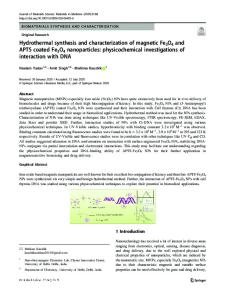Synthesis and Characterization of Co 3 O 4 -Mn x Co 3-x O 4 Core-Shell Nanoparticles
- PDF / 413,415 Bytes
- 6 Pages / 432 x 648 pts Page_size
- 53 Downloads / 393 Views
MRS Advances © 2018 Materials Research Society DOI: 10.1557/adv.2018.453
Synthesis and Characterization of Co3O4-MnxCo3xO4 Core-Shell Nanoparticles Ning Bian1, Robert A. Mayanovic1 and Mourad Benamara2 1
Department of Physics, Astronomy & Materials Science, Missouri State University, Springfield, MO 65897, U.S.A. 2
Institute for Nanoscience & Engineering, University of Arkansas, Fayetteville, AR 72071
ABSTRACT
The mixed-valence oxide Co3O4 nanoparticles, having the normal spinel structure, possess large surface area, active-site surface adsorption properties, and fast ion diffusivities. Consequently, they are widely used in lithium-ion batteries, as well as for gas sensing and heterogeneous catalysis applications. In our research, we use a two-step method to synthesize Co3O4–based core-shell nanoparticles (CSNs). Cobalt oxide (Co 3O4) nanoparticles were successfully synthesized using a wet synthesis method employing KOH and cobalt acetate. Manganese was incorporated into the Co3O4 structure to synthesize inverted Co3O4@MnxCo3xO4 CSNs using a hydrothermal method. By adjustment of pH value, we obtained two different morphologies of CSNs, one resulting in pseudo-spherical and octahedron-shaped nanoparticles (PS type) whereas the second type predominantly have a nanoplate (NP type) morphology. X-ray diffraction (XRD), scanning electron microscopy (SEM), transmission electron microscopy (TEM), and x-ray photoelectron spectroscopy (XPS) have been performed in order to determine the morphological and structural properties of our CSNs, whereas the magnetic properties have been characterized using a superconducting quantum interference device (SQUID) magnetometer. XRD and TEM results show that the CSNs have the same spinel crystal structure throughout the core and shell with an average particle size of ~19.8 nm. Our Co3O4 nanoparticles, as measured prior to CSN formation, are shown to be antiferromagnetic (AFM) in nature as shown by the magnetization data. Our SQUID data indicate that the core-shell nanoparticles have both AFM (due to the Co3O4 core) and ferrimagnetic properties (of the shell) with a coercivity field of 300 Oe and 150 Oe at 5 K for the PS and NP samples, respectively. The magnetization vs temperature data show a spin order-disorder transition at ~33 K and a superparamagnetic blocking temperature of ~90 K for both batches.
INTRODUCTION Core-shell nanoparticles (CSNs) have drawn much attentions due to their finite-size dependent magnetic properties and because of their technological applications[1,2]. Bimagnetic CSNs, which have distinct core and shell magnetic properties, are being
2899
Downloaded from https://www.cambridge.org/core. The Librarian-Seeley Historical Library, on 12 Oct 2018 at 10:53:21, subject to the Cambridge Core terms of use, available at https://www.cambridge.org/core/terms. https://doi.org/10.1557/adv.2018.453
explored for magnetic devices, medicals and other applications[3]. The mixed-valence oxide Co3O4 nanoparticles, having the normal spinel structure, possess large surface
Data Loading...











